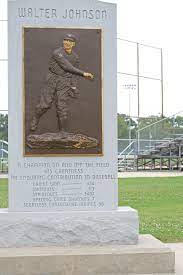 |
| Layered baseball card using Max Scherzer’s most recent ToppsNOW offering |
Max Scherzer, now in his fourteenth season and his seventh in Washington, may be the greatest pitcher to take the mound for the home side in the District of Columbia since Walter Johnson. (I say "may be" because the Homestead Grays never played teams in the White major leagues and we'll never know how those games would have ended up.)
But I digress. Growing up, I graduated from Walter Johnson High School. After the great Senators pitcher, who was nicknamed "The Big Train" for his powerful sidearm fastball, retired, he lived in a house not to far from where the school was built in 1956; the (possibly apocryphal) story is that the school was to be named for a local judge, but a boy wrote a letter to the school board suggesting the pitcher's name. And so was born the Walter Johnson Spartans. Their colors were green and white and their fight song was the same as the Michigan State field cry; when it was consolidated with Woodward High School in 1986, the teams took the name "Wildcats" but otherwise everything stayed the same.
I graduated in 1990, fifteen years before Washington got its own baseball team after a thirty-four year absence and nearly twenty before the city had its own stadium. (Griffith Stadium, where the Senators played until 1961, was torn down to make way for Howard University Hospital, and Robert F. Kennedy Stadium, while perfectly adequate for the first few years of Nationals play and many years of exhibition and old timers games) was far more suited to European or American football than baseball.
One of the things that I remember most fondly about my high school was a memorial that it had in near the front entrance, which had previously stood at Griffith Stadium and was a duplicate of one 
The Walter Johnson plaque in Kansas-
a similar one stood in front of my high
school and is now at Nationals Park.
near Walter Johnson's boyhood home in Coffeyville, Kansas. It's a bronze plaque of him finishing his sidearm delivery, with his name and statistics engraved above and below. The Washington memorial is now at Nationals Park in DC, and I try to visit it every time I see the Nationals play.
When Scherzer became only the fifth pitcher to reach 100 games with 10 or more strikeouts this season--something that Walter Johnson didn't do, but Nolan Ryan, Randy Johnson, Roger Clemens, and Pedro Martinez accomplished--I wanted to memorialize his achievement in a way that seemed fitting. So I created a layered card which suggested a bronze plaque. I like how the shadows turned out, and it's the first horizontally-formatted card painting that I've done.
 |
| The plaque honoring Col. Shaw at Boston Common. A copy of it-in a much brighter gold-is at the National Gallery of Art. |
As for Max, he was supposed to pitch tonight but the game was postponed due to rain. This has been a rough year so far for the Nats, but he'll hopefully add to his legacy as perhaps the second-most notable pitcher for a DC baseball team.
Comments
Post a Comment